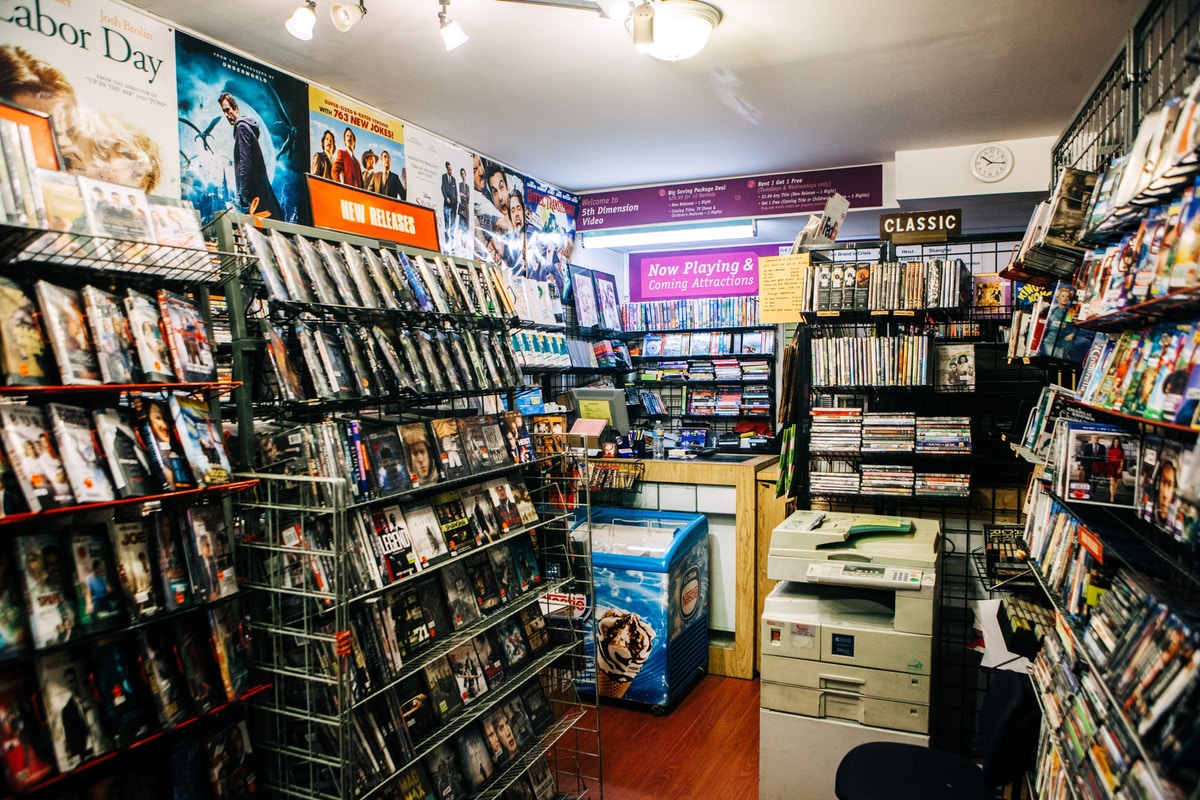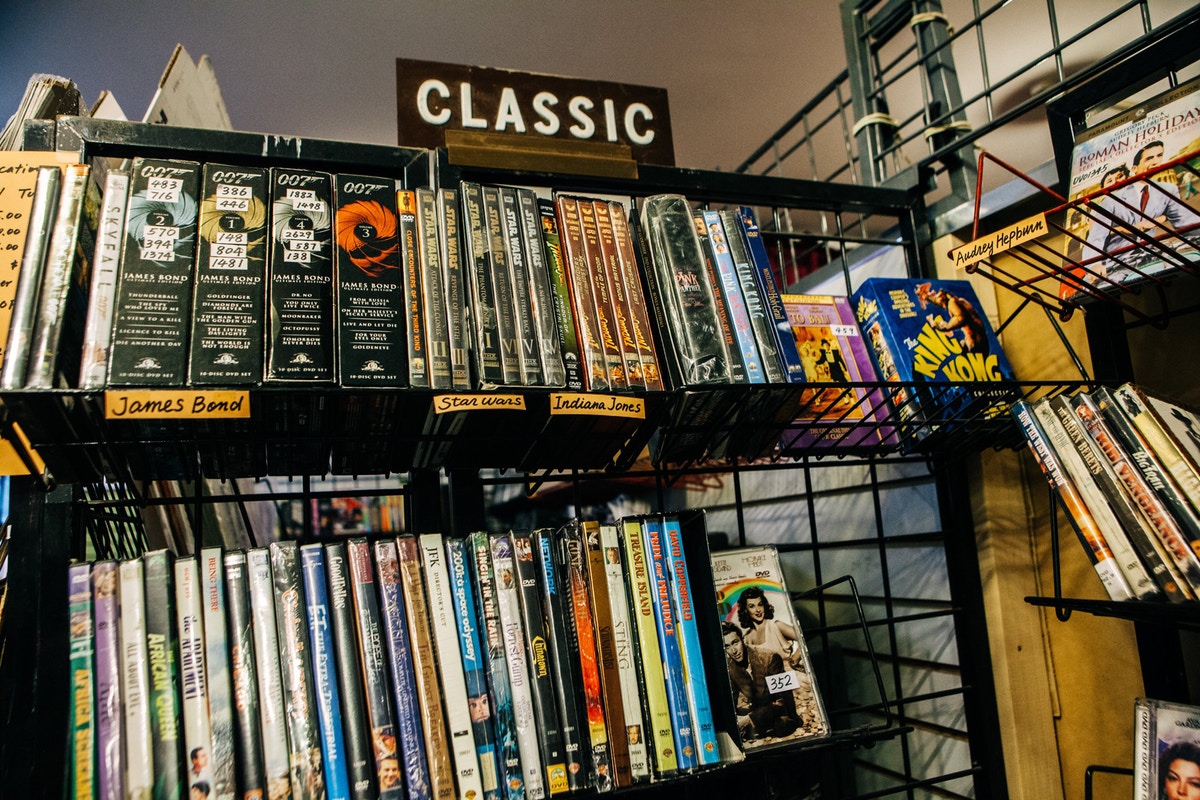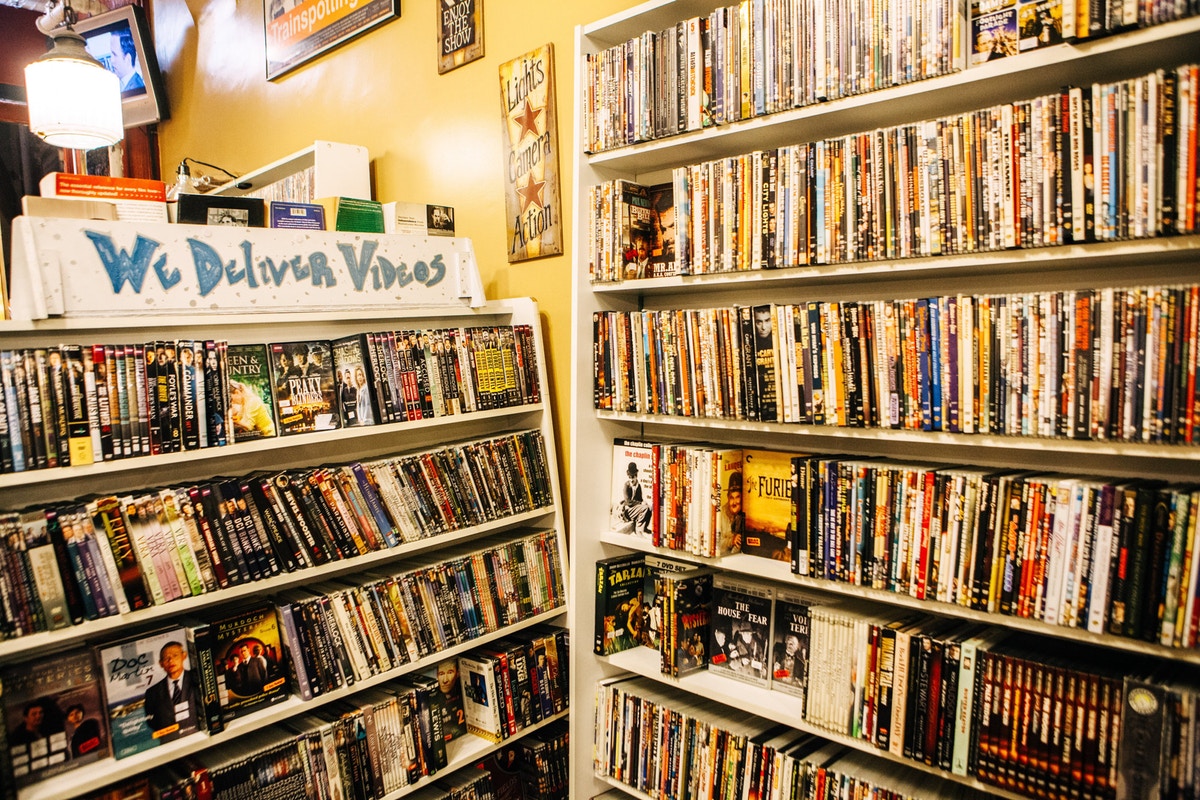The Battle For New York City’s Video Store Culture

After thirty-three years, Videorama is closing. The store, standing at the corner of Dahill Road and 18th Avenue in Borough Park, was the first in its neighborhood. It’s possibly the last place in blue-collar Brooklyn to survive almost entirely on DVD rentals and sales. Though it’s outlived several competitors, it cannot battle the lure of streaming, torrents, and an overall dwindling demand for physical media. Tommy Pittas, a Brooklyn native who took over the business following his father’s retirement, considers the store’s resilience “a labor of love.” Kept afloat by transfers of video or film to disc, he spent the last year debating whether to keep the store running much longer, finally vowing to close the doors in early March (the 7th, to be exact). “It’s not only a financial decision,” Pittas reasons, “but an emotional one.”
The losing battle of video rental and retail is hardly news. Plenty of articles and books have charted the rise, decline, and soft comeback of the culture, highlighting the few stores that remain in New York City. Even as some stores prosper here and in far flung corners of the country (i.e: Vidiots in Los Angeles; Scarecrow Video in Seattle), business remains tricky.

According to Tom Roston’s book I Lost It at the Video Store, over thirty thousand video stores were operating in the United States in the early aughts. In 2004, approximately 9,000 were Blockbuster corporate stores, and since declaring bankruptcy in 2010, 51 franchises remain. Though the mom and pop industry, which Blockbuster helped derail, has the upper hand, it can’t embattle the tens of thousands of Redbox kiosks scattered everywhere and access to multiple platforms like Netflix, Hulu, and Vudu. In 2013, a study confirmed that online streaming sites and piracy hubs like BitTorrent make up an approximate total of $227 million dollars in advertising revenue. Roston fittingly called the video store in the 21st century “an anachronism lurking in the looming shadow of the Internet.”
Considering the city’s rising rents and corporatization, no neighborhood is more primed for a video rental business than another. Video Gallery, Allan’s Alley, and Kim’s Video & Music are among the dozens of rental stores that have shuttered in the city. Videorama is one of the half-dozen or so that remain (not even counting the places that offer rental as a side-business), but is rarely mentioned alongside the stores that stand in more affluent “destination” neighborhoods like Cobble Hill or the Upper East Side.
Still, as Pittas says, Videorama had a clientele that reached as far as Canarsie, Flatbush, and Park Slope, accounting for 24,000 members over three decades. The store began liquidating at the beginning of January, its 13,000 title collection shrinking to 3,000 by mid-February. “Horror, television, and animation were the first to go,” Pittas says. Clearly, there were items here that were so important to people that they needed to be owned, a need that surpasses a borrowed login password.
“I can say that about 80 to 85 percent of our titles cannot be streamed,” says Aaron Hillis, owner of Video Free Brooklyn in Cobble Hill. “Our movies don’t expire.” Hillis, a film journalist for the Village Voice, frequented the Smith Street store since its opening in 2002. When he discovered that it would be closing its doors in 2012, he was even more surprised to find that someone intended to purchase it. “Why would anyone buy a failing video store, unless it wasn’t?” Encouraged by his wife, Hillis did the homework and discovered that the business was sustainable after all, going so far as to acquire it himself; “in the middle of ‘restaurant row,’ in the hippest part of New York, it makes sense.” Boasting a library of over 10,000 discs, Video Free Brooklyn keeps an updated list of their catalog online, not to mention daily specials. The tactile experience of perusing shelves and making conversation is one he treasures. Hillis hopes that people who come in are hungry for better movies, even if they may not know it.

“There are things I have written and published online that you cannot find anymore, so it’s not as though the Internet is forever. I’m signing up new customers every day, and I have enough, new and old, who realize I’m one of the only games in town.”
Business was steady when I visited Video Free Brooklyn in the immediate aftermath of David Bowie’s passing. While I spoke to Hillis, he was tending to customers returning discs and seeking Bowie features like The Man Who Fell to Earth or Labyrinth. After doing a quick search, he found that neither of them were available for streaming on Netflix. Still, he remains only guardedly optimistic, not knowing how long a lifespan the business has. “This is the best part-time job I’ve ever had. I want to share this with people, and it breaks my heart that technology is getting better, faster and cheaper, and film culture isn’t catching up with that.” Indeed, the future of it rests in the hands of younger, tech-happy millennials, but hanging just over Hillis’ shoulder is a sign written on plain printer paper. It reads, in a child’s scrawl, “moovese r osum.” Hillis minds the store for the joy of providing a service, and sees it less as a cash grab than as taking part in “a battle for film culture.”
His sentiments are not unlike those of Will Malitek, owner of Film Noir Video in Greenpoint. “It’s my passion,” Malitek insists. “My goal is to not make ten million dollars.” Standing on 10 Bedford Avenue for the past twelve years, Film Noir was Malitek’s first and only video store experience, a venture motivated by a love for movies and the desire to serve his neighborhood. An immigrant from Danzig, Poland, Malitek lived in Miami six months in the late eighties before moving to Brooklyn—“I like the cold”—and becoming acquainted with the large Polish population, making it easier to predict whether he’d have success with a video store. When he opened Film Noir, it was alongside Photoplay, Reel Life, Videology, and a nearby Blockbuster, the last of which closed soon after he opened. “A good sign,” Malitek thought. Unlike him, they were coasting on a mainstream selection, which he thinks is nonsense.
The ten thousand DVDs in Malitek’s inventory, plus the ten thousand VHS he still has for sale, is comprised of genre films—horror, western, noir, etc—from across the globe, a good chunk of which you cannot find online. He’s still offering recommendations to any of 4,100 registered members who walk in the door (“from teenagers to seniors”) based upon what they’ve watched, not upon a digital algorithm, which the streaming services rely upon. Seeing no point in stopping, Malitek even plans on opening a small repertory cinema on Meserole Street, where he can continue to rent titles while screening them. It’s an idea he’s had ever since opening the store, and can be traced back to seeing Son of Godzilla at Atlantic, a Polish cinema that operates to this day, as a nine year old. “Seeing a film you’ve already seen on DVD on a big screen is a different experience,” he reasons, “so why not do it?”
Malitek’s credential for opening a video store was little more than eclectic taste, not unlike Queens native Howard Salen, who manages Video Room on the Upper East Side. The first video store in Manhattan, Video Room has served as a brick-and-mortar rental store offering media transfer services and same-day delivery since 1980. Armed with a wide breadth of film knowledge—“more than anyone else who was already working there”—and experience as a screenwriter and story editor in the 1960s, Salen began managing the store in 1986.
Though neighbors We Deliver Videos and Fifth Dimension Video are a mere few blocks away, Salen doesn’t sense any competition, especially when it comes to streaming; Video Room’s clientele tends to be on the older, less-tech-savvy side, accounting for the wide variety of foreign and classic cinema that make up their 20,000 title catalog. They even carry over 6,000 VHS, mostly comprised of titles unavailable on DVD.
During our conversation, Salen juggles phone orders and walk-ins, most of whom are older women with their grandchildren or pets. One caller was a guest of the luxury Carlyle Hotel, one of the nearby lodges where Video Room is suggested by concierge staff. To Salen’s right, an enveloped disc is set next to a bike messenger schedule, ready to be delivered to the Film Society of Lincoln Center.
Much like Videorama or Film Noir, Video Room’s bread-and-butter is the transfers, which keeps Salen optimistic about the future. “Grandparents have all the photos of mommy and daddy, these unbelievably extensive collections of VHS tapes and films and slides… they want to be able to throw them on the computer!” In 2015, Salen discovered that transfer revenue was four-times better than in the previous year, and since pushing that to the front, “it’s taken off like crazy.”st)
Though half of We Deliver Videos’ business comes from online orders, Video Room does just fine with more old-fashioned ways. “On a cold day like this, we do about forty to fifty deliveries a day. Walk-ins take up about half the business.” With a delivery radius that reaches as high as 110th street all the way down to Manhattan’s southern tip, We Deliver and Video Room offer a different kind of instant gratification, one that bests technical reliance with face-to-face contact.
The video store’s obsolescence affects not only the selection that becomes increasingly unavailable to customers, but also the tactile experience, which is replaced by a “look, don’t touch” sentiment. Walking along Avenue A, between East 3rd and 4th streets, you pass a familiar sight: a Two Boots Pizzeria. Not terribly remarkable, as they have locations throughout Manhattan and Brooklyn. Look closer and witness something more novel: a video drop slot with a cartoonish monster face drawn on it.
Peering through the window, a tall bookcase hosts dozens of DVDs, adorned with a few yellow paper stars heralding “Staff Picks,” which sit behind glass. Looking at the sign above the entrance, the word “Video,” designed in Two Boots’ familiar font, is cut off by a sign for UCB East. Despite what its website says, rentals and delivery service for Two Boots Video began cutting off at the close of 2014, UCB having taken up the large space previously reserved for the collection, plus the 99-seat Pioneer Theater. The shelf and late-night drop slot remain some of many relics of video store history strewn throughout the city.
When she opened Videology at age 28, Wendy Chamberlain had never worked in a video store. “How hard could it be?”, she thought, having taken film studies in college and previously worked in a cinema. She had lived in Williamsburg for four years before opening the Bedford Avenue store in 2003, the south side’s need for a video store in her interests. A “more accessible, well-lit, communal space” is what she had in mind, with the catalog available online, much like a public library.
Within the first three years, the collection grew from 1,000 to 17,000, with 2005 and 2006 as peak years. The hit taken by the 2008 recession was a shock; Chamberlain thought their business was recession-proof. As business decreased, there was little choice: either reformat or close. Hoping to take the loyal community aspect to the next level, the decision to add a bar and screening room to the business was finalized, with renovations beginning in 2010. She hoped the clientele would transition smoothly, but such was not the case: “Why does Williamsburg need another bar?” Browsing was taken away (hence why Hillis disqualifies the new Videology as a video store), but rentals were never once out of the picture. “We break even,” Chamberlain states, hoping that the still-growing collection will be considered more as an archive. “The number of rentals is negligible.”
She hopes that Videology can partake in the rebirth of video stores, which were great places for film discussion, a thought shared by all the proprietors I interviewed. “Getting to talk to people about movies all day was always the best part of the job for me. We’re lucky that we still have that with our bartenders.”
Videology has hosted film festivals, themed bingo/trivia nights, plus Q&As with filmmakers like Nicolas Winding Refn (Drive). Inside the bar, a projector screens favorites like Heat or The Red Shoes as patrons, college- to middle-aged, enjoy a drink in front of the shelves that still hold cases for new releases or deep-cuts like the Andy Warhol-produced Flesh for Frankenstein. In between the bar and screening room, a small hole-in-the-wall kiosk houses a helpful clerk, offering rental memberships and specials. And though you can’t rent any of the VHS on display at Nitehawk Cinema or its downstairs bar, rechristened as Lo-Res in 2015, those big boxes are rooted in Williamsburg video store history.
One of the founders of that Metropolitan Avenue dine-in cinema, Woods originated the seminal Reel Life in 1997, which was born out of the DIY punk ethos. Having frequented stores like Kim’s and See Here before strolling down to CBGB’s hardcore matinees, Woods found himself and his bandmate with enormous VHS collections. They would hit up independent shops eclipsed by Blockbuster, even going as far as Pennsylvania if there was news of a closing. The 10,000 tape inventory even included European imports that weren’t readily available in the United States, cornering the neighborhood video market- “there was a barbershop feel to it.” As with similar stores, Netflix and the overall transition of Williamsburg greatly affected business, prompting Woods to close the stores in 2008 and transport the cream of the video to his next venture in 2011. Walk into Nitehawk’s lobby or Lo-Res and find glass-encased colorful box art for John Waters or Italian giallo titles, with TVs playing the rare oddities round the clock. “It’s like vinyl,” says Woods. “It’s a part of history.”
Like the 35mm prints or the live musical accompaniment that strengthen Nitehawk’s screenings, the VHS Vault, as it’s called, was implemented to “bring value back to the experience.” Woods doesn’t consider what he does now much different from his Reel Life days, offering obscure midnight picks or cramming a screening’s pre-show with music video and clips taped off of 80s and 90s television. The Wrestling Wednesdays and Simpsons Club nights, with the grainy aesthetic dear to Woods’ heart, are enormously successful, as have been screenings of shot-on-tape favorites like Black Devil Doll From Hell. They even hosted Destroy All VHS!, a program screening VHS-footage compilations, plus a swap meet for enthusiasts of the format. One of that event’s collaborators, Matthew Desiderio, recently hosted a rare 35mm screening of the schlocky Blood Diner, his all-time favorite movie, at Nitehawk. Matthew not only publishes a zine called Horror Boobs and produces VHS-oriented features like The Severed Arm Re-Amputated and the Adjust Your Tracking documentary, but he also is a manager and the DVD buyer for the Union Square comic shop Forbidden Planet.
Towards the back and the right of the store, you’ll see two wide and tall shelves flush with weirdo exploitation and horror titles from imprints like Vinegar Syndrome, Shout Factory, and Arrow Video. Though he doesn’t have time to watch every title he buys, he places his trust in these distributors who possess the same passion for the genre as those who shell out top dollar for the DVDs, Blu-Rays, and, yes, VHS. Though Forbidden Planet sells rather than rents these titles, customers can be sure they’re dealing with a professional offering recommendations to suit curious clients’ tastes, deriving from Desiderio’s experience with Penn Video II in Chelsea.
“When you walk into a video store at 17 and they give you a job, it’s lawless,” Desiderio says, grinning. “I would still be there today if it hadn’t closed. Desiderio worked at Penn Video II from late 1999 until its closure in 2006 after simply walking in and asking if they needed help. The next week, he was working in the store alongside a homeless man named Paul and purchasing stolen box sets of The Godfather and The Sopranos from walk-ins. Soon after they closed, Matt began his tenure as a manager at Forbidden Planet. Last year, Desiderio claims, was the most successful for his DVDs, with the closure of Kim’s on 1st Avenue being an enormous boon. “Aside from the nearby Barnes & Noble, we’re the last place you can find any of this stuff. It’s no single demographic; young, old, men, women. I have the gateway drugs to a wide open field.” Desiderio’s know-how was beneficial for the Museum of Art and Design in Columbus Circle, where he collaborated with Jake Yuzna to create a makeshift video store in an exhibit simply titled “VHS”. The point was to “recapture that feeling of that young age.”
Tommy Pittas was a teenager himself when he began working at Videorama, which has always been a family-and-friends affair. Pittas himself was minding the store during the two times I visited the store after learning about it via Instagram. Inside, it looked as though there had been zero remodeling for several years; the cases were hung in dishwater-colored pockets, all alphabetized, their genres clearly marked. Above the fixtures were promos for Monkeybone and posters for Batman Forever (the fixtures will be sold off, but Pittas will keep the posters—“I framed them myself”). The entire space will again be divided up into three separate stores when it closes, and Pittas will take upon contracting and real estate work full-time.
“It’s gonna take a year or so of accruing customers to make a decent living, but thank God I’m doing okay financially,” Pittas says. “I put my heart and soul into this business. I did everything I could.”
